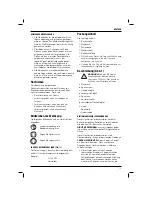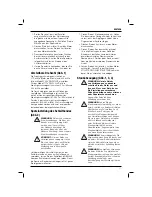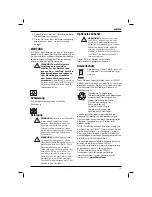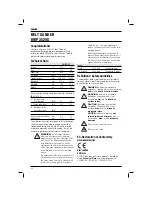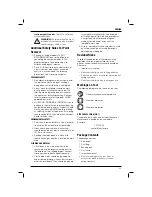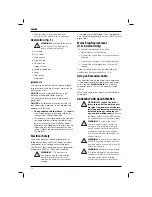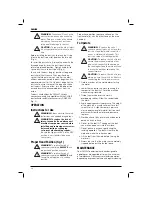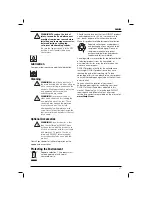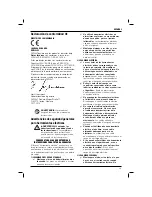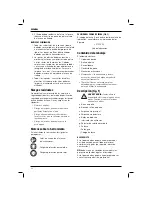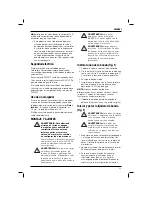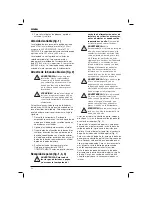
22
ENGLISH
Additional Safety Instructions for
Belt Sanders
• Hold power tool by insulated gripping
surfaces, because the belt may contact
its own cord.
Cutting a “live” wire may make
exposed metal parts of the tool “live” and could
give the operator an electric shock.
• Do not sand metal of any kind with your
sander.
Sparks may be generated by sanding
screws, nails or other metals which may ignite
dust particles.
• Do not wet sand with this sander.
Liquids
may enter the motor housing and cause electric
shock.
• Empty dust bag frequently. Especially
when sanding resin coated surfaces such
as polyurethane, varnish, shellac, etc.
The
accumulation of fine sanding dust particles may
self ignite and cause fire.
• Do not operate this tool for long periods of
time.
Vibration caused by the operating action
of this tool may cause permanent injury to
fingers, hands, and arms. Use gloves to provide
extra cushion, take frequent rest periods, and
limit daily time of use.
• Sanding of lead-based paint, chemically
pressure treated lumber or other materials
that may contain carcinogens is not
recommended.
Sanding of these materials
should only be performed by a professional.
• Clean out your tool often, especially after
heavy use.
Dust and grit containing metal
particles often accumulate on interior surfaces
and could create a risk of serious injury, electric
shock or electrocution.
ALWAYS
disconnect
the sander from the power source before
cleaning.
ALWAYS WEAR SAFETY GLASSES
that conform to ANSI Z87.1.
•
ALWAYS disconnect tool from the power
source before changing abrasive belts
or sheets.
Such preventive safety measures
reduce the risk of starting the power tool
accidentally.
• ALWAYS maintain a firm grip with both
hands on the belt sander handles with
both hands to prevent loss of control.
•
ALWAYS
keep fingers away from the moving
belt and areas where the belt enters the
housing to avoid severe abrasion.
• Do not operate belt sander without all
guards and covers securely in place
.
• To avoid injury, do not use this tool in a
stand that would invert it for use as a
parts.
Loose clothes, jewellery or long hair
can be caught in moving parts.
g)
If devices are provided for the connection
of dust extraction and collection facilities,
ensure these are connected and properly
used.
Use of dust collection can reduce
dust-related hazards.
4) POWER TOOL USE AND CARE
a)
Do not force the power tool. Use the
correct power tool for your application.
The correct power tool will do the job
better and safer at the rate for which it
was designed.
b)
Do not use the power tool if the switch
does not turn it on and off.
Any power
tool that cannot be controlled with the switch
is dangerous and must be repaired.
c)
Disconnect the plug from the power
source and/or the battery pack from
the power tool before making any
adjustments, changing accessories, or
storing power tools.
Such preventive safety
measures reduce the risk of starting the
power tool accidentally.
d)
Store idle power tools out of the reach
of children and do not allow persons
unfamiliar with the power tool or these
instructions to operate the power tool.
Power tools are dangerous in the hands of
untrained users.
e)
Maintain power tools. Check for
misalignment or binding of moving parts,
breakage of parts and any other condition
that may affect the power tool’s operation.
If damaged, have the power tool repaired
before use.
Many accidents are caused by
poorly maintained power tools.
f)
Keep cutting tools sharp and clean.
Properly maintained cutting tools with sharp
cutting edges are less likely to bind and are
easier to control.
g)
Use the power tool, accessories and
tool bits etc., in accordance with these
instructions taking into account the
working conditions and the work to
be performed.
Use of the power tool for
operations different from those intended
could result in a hazardous situation.
5) SERVICE
a)
Have your power tool serviced by a
qualified repair person using only identical
replacement parts.
This will ensure that the
safety of the power tool is maintained.
Summary of Contents for DWP352VS
Page 1: ...DWP352VS ...
Page 3: ...1 Figure 1 d i c h e f g Figure 2 Figure 3 j a k l m n b b ...
Page 4: ...2 Figure 4 DWV9000 ...
Page 119: ...117 ...








